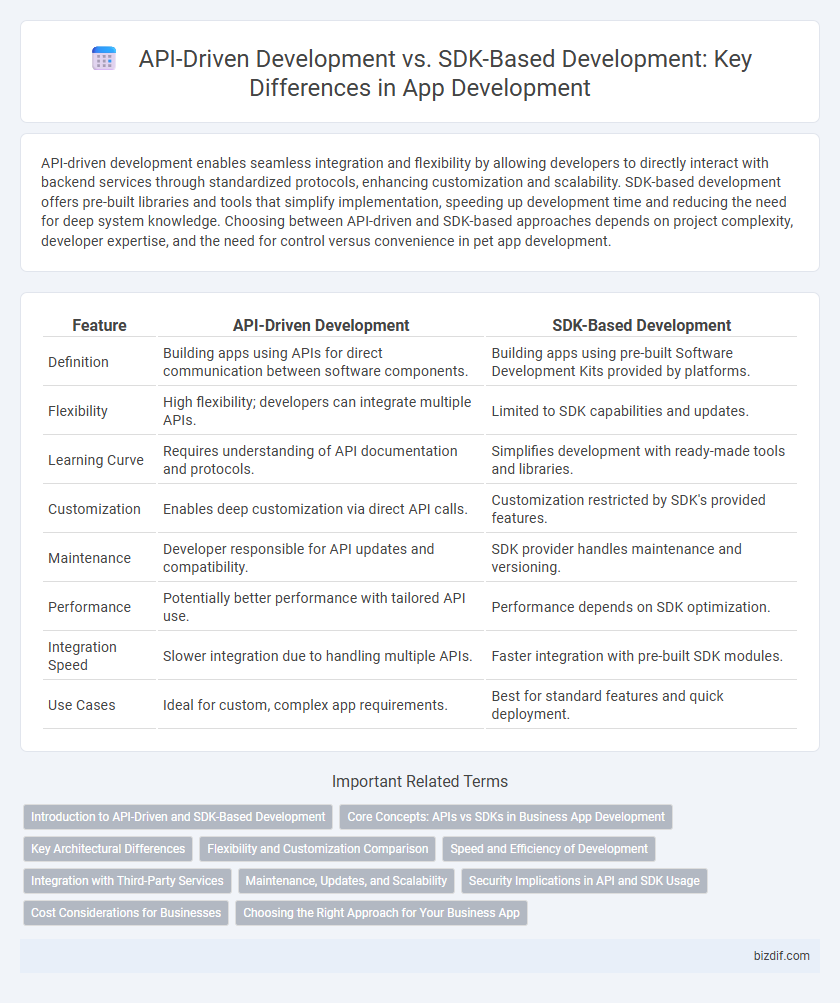API-driven development enables seamless integration and flexibility by allowing developers to directly interact with backend services through standardized protocols, enhancing customization and scalability. SDK-based development offers pre-built libraries and tools that simplify implementation, speeding up development time and reducing the need for deep system knowledge. Choosing between API-driven and SDK-based approaches depends on project complexity, developer expertise, and the need for control versus convenience in pet app development.
Table of Comparison
| Feature | API-Driven Development | SDK-Based Development |
|---|---|---|
| Definition | Building apps using APIs for direct communication between software components. | Building apps using pre-built Software Development Kits provided by platforms. |
| Flexibility | High flexibility; developers can integrate multiple APIs. | Limited to SDK capabilities and updates. |
| Learning Curve | Requires understanding of API documentation and protocols. | Simplifies development with ready-made tools and libraries. |
| Customization | Enables deep customization via direct API calls. | Customization restricted by SDK's provided features. |
| Maintenance | Developer responsible for API updates and compatibility. | SDK provider handles maintenance and versioning. |
| Performance | Potentially better performance with tailored API use. | Performance depends on SDK optimization. |
| Integration Speed | Slower integration due to handling multiple APIs. | Faster integration with pre-built SDK modules. |
| Use Cases | Ideal for custom, complex app requirements. | Best for standard features and quick deployment. |
Introduction to API-Driven and SDK-Based Development
API-driven development emphasizes creating applications by integrating external services through well-defined interfaces, enabling seamless communication and data exchange across platforms. SDK-based development leverages pre-built software development kits that offer comprehensive tools, libraries, and documentation, accelerating the creation of feature-rich applications with native capabilities. Both approaches streamline app development workflows, with APIs providing modular interaction and SDKs delivering ready-to-use functionalities tailored for specific platforms.
Core Concepts: APIs vs SDKs in Business App Development
APIs (Application Programming Interfaces) enable seamless communication between different software components, allowing businesses to integrate diverse functionalities and streamline app development with modular, reusable services. SDKs (Software Development Kits) provide a comprehensive set of development tools, including APIs, libraries, and documentation, tailored to facilitate faster and more consistent app creation within specific platforms or ecosystems. Choosing between API-driven development and SDK-based development depends on business requirements for flexibility, control, and speed in delivering robust, scalable applications.
Key Architectural Differences
API-driven development centers on the communication between software components through well-defined interfaces, enabling flexible integration and modular architecture. SDK-based development offers pre-built tools and libraries that accelerate app creation but may limit customization due to fixed functionalities. The key architectural difference lies in the level of abstraction: APIs provide granular control at the interface level, while SDKs package multiple APIs into cohesive development environments.
Flexibility and Customization Comparison
API-driven development offers greater flexibility by enabling developers to integrate diverse services and customize functionalities at a granular level through direct access to endpoints. SDK-based development provides a more streamlined experience with pre-built tools and libraries, but it often limits customization to the predefined capabilities within the SDK. Choosing API-driven approaches facilitates tailored feature sets and dynamic interactions, while SDKs expedite development with consistent, though less adaptable, components.
Speed and Efficiency of Development
API-driven development accelerates app creation by enabling direct, standardized communication with backend services, reducing the need for extensive custom code. SDK-based development can streamline integration by providing pre-built tools and libraries, but may introduce overhead in adapting the SDK to project-specific requirements. Developers often achieve faster prototyping and iteration cycles with APIs, while SDKs can enhance efficiency when working within well-defined platforms or ecosystems.
Integration with Third-Party Services
API-driven development enables seamless integration with third-party services by providing standardized endpoints that facilitate direct communication between applications and external platforms. SDK-based development offers pre-built libraries and tools that simplify implementation but may limit customization and flexibility in handling diverse third-party service protocols. Choosing between API and SDK approaches depends on the desired balance between streamlined integration and the need for granular control over service interactions.
Maintenance, Updates, and Scalability
API-driven development offers enhanced scalability by enabling seamless integration with diverse services and easier maintenance through modular code updates without altering the client application. SDK-based development simplifies initial implementation with pre-built tools but can introduce challenges in maintaining consistency and updating features across multiple SDK versions. Choosing API-driven approaches often results in more flexible, maintainable applications that can adapt rapidly to evolving requirements and scalability demands.
Security Implications in API and SDK Usage
API-driven development often exposes endpoints that require rigorous authentication and encryption measures to prevent unauthorized access and data breaches, making robust token management and rate limiting essential for security. SDK-based development encapsulates API interactions within pre-built libraries, reducing direct API exposure but increasing the risk of embedded vulnerabilities if the SDK is outdated or compromised. Ensuring secure communication protocols, continuous SDK updates, and comprehensive validation during API interactions are critical to mitigating security risks in both approaches.
Cost Considerations for Businesses
API-driven development often reduces upfront costs by enabling businesses to integrate existing services without extensive in-house development, whereas SDK-based development may require higher initial investment for customization and maintenance. APIs promote scalability and flexibility, potentially lowering long-term expenses through modular updates and third-party integrations. Conversely, SDKs can increase costs linked to dedicated support and version control, impacting the total cost of ownership depending on project complexity and development timelines.
Choosing the Right Approach for Your Business App
API-Driven Development enables businesses to build highly customizable applications by integrating diverse services through flexible, standardized interfaces, promoting scalability and faster innovation cycles. SDK-Based Development offers pre-built libraries and tools that accelerate the development process with streamlined functionalities, ideal for companies needing rapid deployment and consistent user experiences. Selecting the right approach depends on your app's complexity, desired control over features, and resource availability, with API-driven models suiting bespoke solutions and SDK-based methods fitting efficiency-centered projects.
API-Driven Development vs SDK-Based Development Infographic

 bizdif.com
bizdif.com